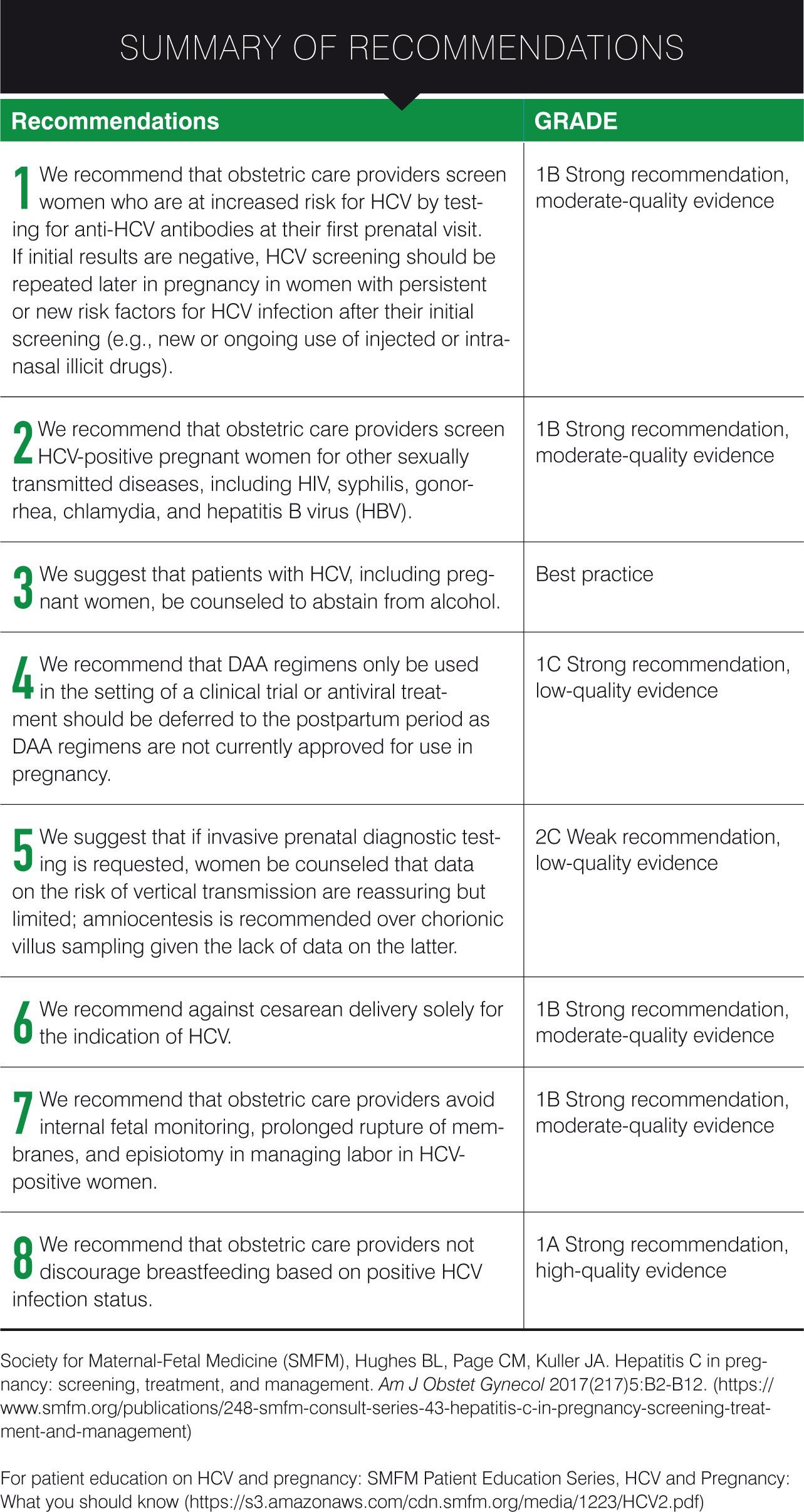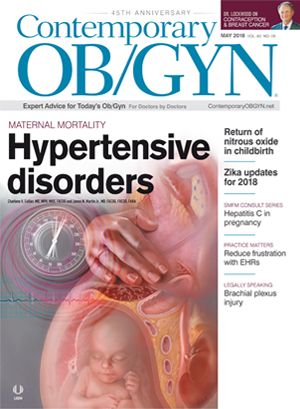Hepatitis C in pregnancy: Screening, treatment, and management
In the United States, 1% to 2.5% of pregnant women are infected with hepatitis C virus (HCV), which carries an approximately 5% risk of transmission from mother to infant. HCV can be transmitted to an infant in utero or during the peripartum period.
Summary of Recommendations

In the United States, 1% to 2.5% of pregnant women are infected with hepatitis C virus (HCV), which carries an approximately 5% risk of transmission from mother to infant. HCV can be transmitted to an infant in utero or during the peripartum period. Two primary concerns arise from HCV in pregnancy: 1) maternal well-being, i.e., the effect of pregnancy on the course of chronic HCV infection; and 2) fetal well-being, namely mother-to-infant transmission of HCV and the impact of maternal infection on pregnancy outcomes.
Q | What is the natural course of HCV infection?
In addition to vertical transmission, HCV is transmitted through percutaneous exposure to blood through use of contaminated needles for injection of illicit drugs or during occupational exposure. Sexual intercourse is an inefficient means of transmission. The first 6 months after exposure to HCV is referred to as acute HCV infection, which is asymptomatic in 75% of cases. When symptoms occur, they include abdominal pain, nausea, anorexia, jaundice, or malaise. Without treatment, approximately 15% of infected individuals spontaneously clear HCV within 6 months of infection, although some estimate this number to be as high as 45%. Those who do not clear the virus harbor it for the rest of their lives and develop chronic HCV infection, which accounts for most HCV-associated morbidity and mortality, mainly due to cirrhosis and hepatocellular carcinoma.
Q | What is the impact of pregnancy on HCV?
Researchers speculate that down-regulation of the maternal immune response that occurs during pregnancy may reduce the amount of immune-mediated hepatocellular damage caused by HCV. This mechanism would also account for the decrease in alanine transaminase (ALT) levels seen in pregnant women with HCV and the increase in serum levels of HCV RNA during the second and third trimesters of pregnancy. Some histological evidence also suggests that pregnancy may be associated with a decrease in HCV-mediated hepatic injury, but data are conflicting.
Q | What is the impact of HCV on pregnancy outcomes?
HCV infection is associated with adverse pregnancy outcomes. Two population-based, retrospective cohort studies and a recent meta-analysis found that infants born to women infected with HCV were more likely to have poor birth outcomes, including fetal growth restriction, low birth weight (LBW), and congenital anomalies, and to be delivered preterm. It is difficult to know with certainty whether the increased risk of adverse outcomes such as fetal growth restriction and LBW is due to the viral effect of HCV or to potential confounders in the population being studied.
In addition, several studies have reported higher rates of gestational diabetes in HCV-infected women compared with noninfected women, although in one of these studies, this association was limited to women with excessive weight gain during pregnancy. Another population-based, retrospective cohort study found that infants born to HCV-infected women were more likely to have feeding difficulties and other adverse neonatal outcomes, including cephalohematoma, brachial plexus injury, fetal distress, intraventricular hemorrhage, or neonatal seizures.
Intrahepatic cholestasis of pregnancy (ICP) has also been associated with HCV infection. The overall incidence of ICP in the general obstetric population is 0.2% to 2.5%, while the odds of developing ICP are 20-fold higher in HCV-infected pregnant women. Given the increased risk of fetal death associated with ICP, diagnosis of this disease in pregnant women is important.
Currently, a multicenter, prospective observational cohort study is underway to evaluate pregnancy outcomes in women with HCV. Outcomes being studied include preterm delivery, gestational diabetes, preeclampsia, cholestasis, and infant birth weight (Clinicaltrials.gov: NCT01959321).
Q | What is the rate of vertical transmission of HCV?
Vertical transmission of HCV is the leading cause of HCV infection in children. While one-third to one-half of mother-to-child transmission of HCV appears to occur in utero prior to the last month of pregnancy, the remainder is thought to occur either in the last month of pregnancy or during delivery. In women who are coinfected with HIV and HCV, risk of vertical transmission is almost double that in women infected only with HCV.
In general, vertical transmission of HCV is thought to be a risk only for women with detectable HCV RNA during pregnancy. Whether the level of HCV viremia correlates with risk of transmission has yet to be determined. Several studies have shown that higher viral loads correlate with an increased risk of transmission, whereas other studies have failed to find such an association.
Q | Who should be screened for HCV during pregnancy and what is the ideal screening test for HCV?
Current guidelines from the American College of Obstetricians and Gynecologists (ACOG) and the Centers for Disease Control and Prevention (CDC) recommend risk-based screening for HCV in pregnant women. We recommend that obstetric care providers screen women who are at increased risk for HCV by testing for anti-HCV antibodies at their prenatal visit. If initial results are negative, HCV screening should be repeated later in pregnancy in women with persistent or new risk factors for HCV infection after their initial screening (e.g., new or ongoing use of injected or intranasal illicit drugs).
The standard screening test for HCV is an anti-HCV antibody test. Anti-HCV antibodies usually develop 2 to 6 months after exposure-during the acute phase of infection-and persist throughout life. A positive test result indicates one of the following: the patient has active HCV infection (acute or chronic), the patient had a past infection that has resolved, or the result is a false positive.
A positive anti-HCV antibody result should be followed by a quantitative nucleic acid test for HCV RNA. Diagnosis of HCV infection depends on detection of anti-HCV antibodies and HCV ribonucleic acid (RNA). HCV viremia, i.e., the presence of HCV RNA in the blood, indicates active infection and can first be detected 1 to 3 weeks after exposure.
Q | What other additional evaluation should occur?
For pregnant women with confirmed active HCV infection, a quantitative HCV RNA test should be done to determine baseline viral load. Basic laboratory testing to evaluate the extent of liver disease should include the following laboratory tests: bilirubin, ALT and aspartate aminotransferase (AST), albumin, platelet count, and prothrombin time. To help plan future treatment, testing for HCV genotype should also be performed (if not done previously).
In light of common risk factors, we recommend that obstetric care providers screen HCV-positive pregnant women for other sexually transmitted diseases, including HIV, syphilis, gonorrhea, chlamydia, and hepatitis B (HBV). Patients with HBV infection and a high viral load can be offered antenatal treatment; infants should receive the hepatitis B vaccine as well as hepatitis immune globulin. Hepatitis A virus (HAV) infection can also worsen hepatic damage if present with HCV infection. The Advisory Committee on Immunization Practices (ACIP) recommends that women with HCV infection who are found to be at risk of HBV and/or HAV be vaccinated, and it is safe to do so during pregnancy.
Q | Should HCV be treated pharmacologically during pregnancy?
Until 2011, the standard-of-care treatment for chronic HCV was pegylated interferon (PegIFN)-α and ribavirin. In 2011, direct-acting antiviral medications (DAAs) were released, revolutionizing treatment of HCV. These drugs directly inhibit proteins involved in HCV replication, have fewer side effects than interferon-based regimens, and have led to sustained virological response (SVR) rates as high as 60% to 100%. Treatment regimens usually involve multiple DAAs to prevent viral resistance.
Because there are no adequate human data regarding any of the effects of second-generation DAAs in pregnancy, we recommend that DAA regimens only be used in the setting of a clinical trial or antiviral treatment should be deferred to the postpartum period as DAA regimens are not currently approved for use in pregnancy.
Q | What are the principles of medical management of HCV during pregnancy?
Any woman who is diagnosed with HCV infection during pregnancy should be referred to a hepatologist or infectious disease specialist experienced in management of hepatitis in order to establish long-term care.
Use of even modest amounts of alcohol has been associated with progression of liver disease, and we suggest that patients with HCV, including pregnant women, be counseled to abstain from alcohol.
Serial laboratory surveillance of liver function or serial viral load assessment during pregnancy in HCV-positive women is generally not recommended. As discussed previously, serum levels of ALT tend to decrease during the second and third trimesters of pregnancy, i.e., liver function is expected to improve, not worsen, during pregnancy.
Q | Is invasive prenatal diagnostic testing safe in pregnant women with HCV?
Amniocentesis does not appear to increase risk of vertical transmission, although this conclusion is based on limited data. No studies have been published on risk of vertical transmission of HCV with other invasive prenatal testing modalities, including chorionic villus sampling (CVS). We suggest that if invasive prenatal diagnostic testing is requested, women be counseled that data on the risk of vertical transmission are reassuring but limited; amniocentesis is recommended over CVS given lack of data on the latter.
Q | Does mode of delivery affect risk of vertical transmission?
Mode of delivery-vaginal versus cesarean-has not been shown to be a risk factor for vertical transmission of HCV. However, because all published studies on mode of delivery and risk of vertical transmission of HCV are observational and most did not assess viral load at the time of delivery, these results should be interpreted cautiously. We recommend against cesarean delivery solely for the indication of HCV.
Q | Does labor management affect risk of vertical transmission?
Several factors in labor management may be associated with increased risk of vertical transmission of HCV, namely prolonged rupture of membranes, internal fetal monitoring, and episiotomy. Based on the available evidence, we recommend that obstetric care providers avoid internal fetal monitoring, prolonged rupture of membranes, and episiotomy in managing labor in HCV-positive women, unless it is unavoidable in the course of management. We also recommend that obstetric care providers avoid early amniotomy and episiotomy in managing labor in HCV-positive women.
Q |Is breastfeeding safe for HCV-positive mothers?
Breastfeeding does not appear to affect the risk of vertical transmission of HCV. We recommend against discouraging breastfeeding based on a positive HCV infection status. If women have cracked and bleeding nipples, milk should be expressed and discarded.
Q | How should infants born to HCV-positive women be screened for HCV infection?
Because anti-HCV antibodies can be transmitted across the placenta from a pregnant woman to the fetus, the presence of anti-HCV antibodies in a neonate’s serum soon after delivery is not diagnostic of neonatal infection. The American Academy of Pediatrics and CDC recommend screening of infants born to HCV-positive women for anti-HCV antibodies after age 18 months or for HCV RNA on two occasions in infants older than age 1 month.

